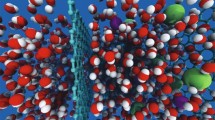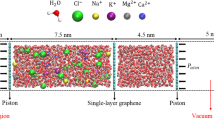Abstract
Using molecular dynamics simulations, we analyze ion separation and water purification through a piston-driven graphene/carbon-nanotube filter in the presence of an external electric field. Three different magnitudes of electric field are applied along the nanotube’s axial direction with the goal of separating sodium and chloride ions in a NaCl aqueous solution. For comparison purposes, we also study the same system in zero fields. Our results show that sufficiently large values of the electric field strength greatly improve the ion separation process. At the highest field strength, the theoretical efficiency of the filter in removing salt from water exceeds 95% indicating its applicability in commercial filtration processes to produce fresh water. These results suggest that the proposed set-up can be used to design highly efficient nanostructured membranes for water desalination.







Similar content being viewed by others
Data availability
The data that support the findings of this study are available from the corresponding author, upon reasonable request.
References
Elimelech M, Phillip WA (2011) The future of seawater desalination: energy, technology, and the environment. Science 333(6043):712–717. https://doi.org/10.1126/science.1200488
Pendergast MM, Hoek EM (2011) A review of water treatment membrane nanotechnologies. Energy Environ. Sci. 4(6):1946–1971
Corry B (2008) Designing carbon nanotube membranes for efficient water desalination. J. Phys. Chem. B 112(5):1427–1434. https://doi.org/10.1021/jp709845u
Thomas M, Corry B (2016) A computational assessment of the permeability and salt rejection of carbon nanotube membranes and their application to water desalination. Philos Trans Royal Soc A 374(2060):20150020
Cohen-Tanugi D, McGovern RK, Dave SH, Lienhard JH, Grossman JC (2014) Quantifying the potential of ultra-permeable membranes for water desalination. Energy Environ. Sci. 7(3):1134–1141
Konatham D, Yu J, Ho TA, Striolo A (2013) Simulation insights for graphene-based water desalination membranes. Langmuir 29(38):11884–11897. https://doi.org/10.1021/la4018695
Cohen-Tanugi D, Grossman JC (2012) Water desalination across nanoporous graphene. Nano Lett. 12(7):3602–3608. https://doi.org/10.1021/nl3012853
Lee HD, Kim HW, Cho YH, Park HB (2014) Experimental evidence of rapid water transport through carbon nanotubes embedded in polymeric desalination membranes. Small 10(13):2653–2660
Zhao K, Wu H (2015) Fast water thermo-pumping flow across nanotube membranes for desalination. Nano Lett. 15(6):3664–3668
Das R, Ali ME, Abd Hamid SB, Ramakrishna S, Chowdhury ZZ (2014) Carbon nanotube membranes for water purification: a bright future in water desalination. Desalination 336:97–109
Majumder M, Chopra N, Andrews R, Hinds BJ (2005) Nanoscale hydrodynamics: enhanced flow in carbon nanotubes. Nature 438(7064):44. https://doi.org/10.1038/43844a
Kar S, Bindal RC, Tewari PK (2012) Carbon nanotube membranes for desalination and water purification: challenges and opportunities. Nano Today 7(5):385–389
Hong Y, Zhang J, Zhu C, Zeng XC, Francisco JS (2019) Water desalination through rim functionalized carbon nanotubes. J. Mater. Chem. A 7(8):3583–3591
Azamat J, Sardroodi JJ (2014) The permeation of potassium and chloride ions through nanotubes: a molecular simulation study. Monatshefte für Chemie-Chemical Monthly 145(6):881–890
Goh P, Ismail A, Ng B (2013) Carbon nanotubes for desalination: performance evaluation and current hurdles. Desalination 308:2–14
Zhang D, Yan T, Shi L, Peng Z, Wen X, Zhang J (2012) Enhanced capacitive deionization performance of graphene/carbon nanotube composites. J. Mater. Chem. 22(29):14696–14704
Hanasaki I, Nakatani A (2006) Hydrogen bond dynamics and microscopic structure of confined water inside carbon nanotubes. J. Chem. Phys. 124(17):174714. https://doi.org/10.1063/1.2194540
Kalra A, Garde S, Hummer G (2003) Osmotic water transport through carbon nanotube membranes. Proc. Natl. Acad. Sci. 100(18):10175–10180
Koga K, Gao GT, Tanaka H, Zeng XC (2001) Formation of ordered ice nanotubes inside carbon nanotubes. Nature 412(6849):802–805. https://doi.org/10.1038/35090532
Cohen-Tanugi D, Lin LC, Grossman JC (2016) Multilayer Nanoporous Graphene membranes for water desalination. Nano Lett. 16(2):1027–1033. https://doi.org/10.1021/acs.nanolett.5b04089
Joshi R, Carbone P, Wang F-C, Kravets VG, Su Y, Grigorieva IV, Wu H, Geim AK, Nair RR (2014) Precise and ultrafast molecular sieving through graphene oxide membranes. Science 343(6172):752–754
Nair R, Wu H, Jayaram P, Grigorieva I, Geim A (2012) Unimpeded permeation of water through helium-leak–tight graphene-based membranes. Science 335(6067):442–444
Wei N, Peng X, Xu Z (2014) Understanding water permeation in graphene oxide membranes. ACS Appl. Mater. Interfaces 6(8):5877–5883. https://doi.org/10.1021/am500777b
Rinne KF, Gekle S, Bonthuis DJ, Netz RR (2012) Nanoscale pumping of water by AC electric fields. Nano Lett. 12(4):1780–1783. https://doi.org/10.1021/nl203614t
Ritos K, Borg MK, Mottram NJ, Reese JM (2016) Electric fields can control the transport of water in carbon nanotubes. Philos Trans Royal Soc A 374(2060):20150025
Su J, Guo H (2011) Control of unidirectional transport of single-file water molecules through carbon nanotubes in an electric field. ACS Nano 5(1):351–359
Lohrasebi A, Rikhtehgaran S (2018) Ion separation and water purification by applying external electric field on porous graphene membrane. Nano Res. 11(4):2229–2236
Azamat J (2016) Functionalized graphene nanosheet as a membrane for water desalination using applied electric fields: insights from molecular dynamics simulations. J. Phys. Chem. C 120(41):23883–23891
Azamat J, Ebrahimzadeh AR, Sardroodi JJ, Gholinezhad L (2015) Molecular dynamics simulation of nanoporous graphene as membrane for ion separation under induced electric field. J. Comput. Theor. Nanosci. 12(8):1512–1518
Park JH, Sinnott SB, Aluru NR (2006) Ion separation using a Y-junction carbon nanotube. Nanotechnology 17(3):895
Rikhtehgaran S, Lohrasebi A (2015) Water desalination by a designed nanofilter of graphene-charged carbon nanotube: a molecular dynamics study. Desalination 365:176–181
Li D (2018) Water quality monitoring and management : basis, technology and case studies1st edn. Elsevier, Sandiego
Humphrey W, Dalke A, Schulten K (1996) VMD: visual molecular dynamics. J. Mol. Graph. 14(1):33–38, 27-38. https://doi.org/10.1016/0263-7855(96)00018-5
Plimpton S (1993) Fast parallel algorithms for short-range molecular dynamics. Sandia National Labs., Albuquerque
Hoover WG (1985) Canonical dynamics: equilibrium phase-space distributions. Phys. Rev. A 31(3):1695
Plimpton S (1995) Fast Parallel Algorithms for Short-Range Molecular Dynamics. J. Comp. Phys. 117:1-19. http://lammps.sandia.gov
Jorgensen WL, Maxwell DS, Tirado-Rives J (1996) Development and testing of the OPLS all-atom force field on conformational energetics and properties of organic liquids. J. Am. Chem. Soc. 118(45):11225–11236
Nasrabadi AT, Foroutan M (2011) Ion-separation and water-purification using single-walled carbon nanotube electrodes. Desalination 277(1–3):236–243
Jorgensen WL, Chandrasekhar J, Madura JD, Impey RW, Klein ML (1983) Comparison of simple potential functions for simulating liquid water. J. Chem. Phys. 79(2):926–935
Allen MP, Tildesley DJ (1987) Computer simulation of liquids. Clarendon Press ; Oxford University Press, Oxford England New York
Darden T, York D, Pedersen L (1993) Particle mesh Ewald: an N log (N) method for Ewald sums in large systems. J. Chem. Phys. 98(12):10089–10092
Beu TA (2010) Molecular dynamics simulations of ion transport through carbon nanotubes. I. Influence of geometry, ion specificity, and many-body interactions. J. Chem. Phys. 132(16):164513
Wang L, Dumont RS, Dickson JM (2012) Nonequilibrium molecular dynamics simulation of water transport through carbon nanotube membranes at low pressure. J. Chem. Phys. 137(4):044102
Bounds DG (1985) A molecular dynamics study of the structure of water around the ions Li+, Na+, K+, Ca++, Ni++ and Cl. Mol. Phys. 54(6):1335–1355. https://doi.org/10.1080/00268978500101041
Author information
Authors and Affiliations
Corresponding author
Ethics declarations
Conflict of interest
The authors declare that they have no competing interests.
Code availability
The codes of this study are available from the corresponding author, upon reasonable request.
Additional information
Publisher’s note
Springer Nature remains neutral with regard to jurisdictional claims in published maps and institutional affiliations.
Rights and permissions
About this article
Cite this article
Rikhtehgaran, S., Wille, L.T. The effect of an electric field on ion separation and water desalination using molecular dynamics simulations. J Mol Model 27, 21 (2021). https://doi.org/10.1007/s00894-020-04642-8
Received:
Accepted:
Published:
DOI: https://doi.org/10.1007/s00894-020-04642-8




